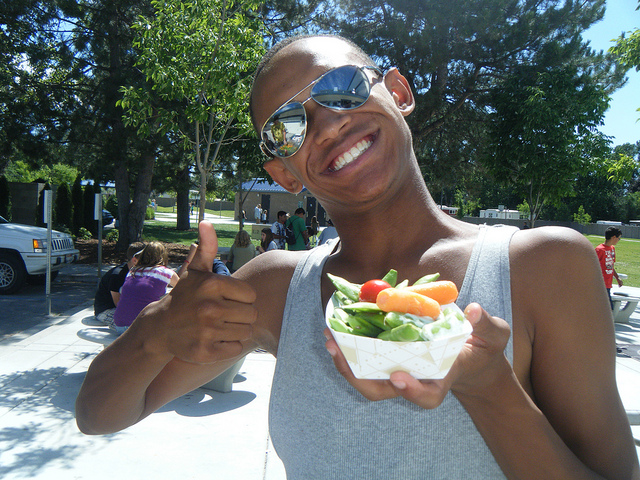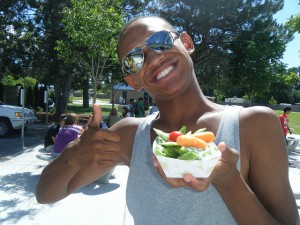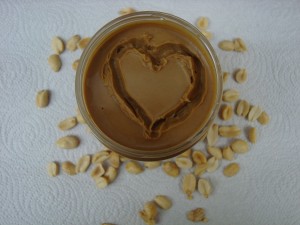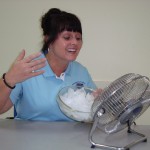
by Angela Hinkle | Jun 27, 2014
“School’s out!” Time to head outdoors to play.
In their Physical Activity Guidelines, the Department of Health and Human Services, http://www.health.gov, recommends at least one hour of moderate to vigorous physical activity every day for overall better health. No worries, though. You don’t have to do it all at once and what you and your family choose to do should be fun and keep your interest.
 Here are a few reminders when staying physical:
Here are a few reminders when staying physical:
- Water, water, and more water – make sure you replenish your fluids. Try drinking your water with ice, fruit, bendable straws, or from bottles with funky-colored sleeves to keep it interesting. Keep plenty of fruits and veggies on hand for snacks to stay hydrated as well.
- Apply, apply, and apply – sunscreen, that is. Set up a sunscreen station so everyone knows where to find the various bottles, sticks, and sprays of sunscreen. Small bottles of sunscreen with hooks that hang on belt loops are also becoming more readily available.
- Pick the best time of day for you. For many, earlier in the day or later in the afternoon are a little cooler, which makes it easier to be outside. (Unfortunately, those are mosquitoes’ favorite times of the day, too, so be sure to use protection against mosquito and other bug bites.)
- Pick the right environment. Make sure you have some shady spots or have the ability to come indoors to cool off.
- More water – water balloons, water squirters, and sprinklers are always fun. Poke holes in an empty plastic 2- liter soda bottle, attach a hose to the bottle opening, and hang it upside down to make a great outdoor shower.
So what are you waiting for? Go out and (safely) have some fun in the sun!

by Angela Hinkle | Mar 2, 2014

Enjoy the taste of eating right.
Taste tops nutrition as the main reason why we buy one food over another, as consumer research has clearly shown. Even though social, emotional, and health factors do have important roles to play, the foods people enjoy are probably the ones they eat the most. The key message for National Nutrition Month® – March 2014 focuses on encouraging personalized healthy eating styles – showing how we can combine taste and nutrition to make healthy meals.
This year, the Academy of Nutrition and Dietetics encourages everyone to “Enjoy the Taste of Eating Right”. Because taste is the major influencer of what we eat, it’s important to balance choosing the foods we like with those that provide the nutrients we need.
When it comes to choosing what to eat, nutrition is important, but flavor is the true motivator and the key to eating right. We have over 10,000 taste buds, so we should use them to discover a world of tasty nutritious foods.
- Try one new fruit, vegetable, or whole grain each week.
- When eating out, try ethnic foods from Asia, Europe, or Africa because they often have many healthy options.
- When cooking at home, try a new twist on old favorites. Grill vegetables and fish, make kabobs, bake the potatoes instead of mashing them, and use that spice rack to add zest.
- If you’re sticking with the tried and true foods you know you like, be sure to read the nutrition labels to help you develop a plan for healthy eating that emphasizes a balance of foods.
Return to the basics of healthful eating starting this month. Enjoy the Taste of Eating Right: eat right, your way, every day.
Learn more about how you can enjoy the taste of eating right by visiting www.eatright.org and by contacting your local UF/IFAS Extension Office.

by Angela Hinkle | Feb 28, 2014

Family Eats Sofa
No, not the kind you sit on. SoFAS stands for “Solid Fats and Added Sugars”. Even though the Dietary Guidelines for Americans recommends no more than about 15% of daily calories should come from SoFAS, Americans of both sexes and all ages get closer to 35% of their daily calories from SoFAS – nearly 800 calories a day. This isn’t a big surprise when considering the top food sources of SoFAS: pies, cakes, cookies, donuts; fruit, energy, and sports drinks; pizza; ice cream; and sausages, hot dogs, bacon, and ribs. Each of these foods adds about 100-150 calories on average to the daily American diet.
Solid Fats are saturated or trans-fats that are solid at room temperature. Added sugars are in foods that have sugar added to them during processing or preparation. SoFAS also are known as “empty calories.” Many people eat those empty calories in place of nutrient-rich foods their bodies need. SoFAS provide little or no nutritional value and they can have serious implications on health, including heart disease, weight gain, and tooth decay.
Nutrient dense foods provide key nutrients for the calories consumed. These nutrients build, repair, and maintain body tissues, regulate body processes, and give the body fuel for an active lifestyle. Nutrient-rich food choices fill you up so there is little room left for the empty calories from SoFAS that offer few nutrients the body can use. Pick foods rich in vitamins, minerals, dietary fiber, lean protein, and healthy fats from all the food groups before eating foods with SoFAS.
To see how many empty calories are in some favorite foods, check out How Do I Count Empty Calories? You can calculate your exact calorie needs on the ChooseMyPlate Super Tracker site. Don’t want to count calories but want to be sure not to eat too many empty calories? Read the Nutrition Facts Label on food packages and choose foods that are lower in fat and have less total sugar.
Eat a variety of healthy foods from each MyPlate food group every day. And get off the SoFAS – avoid the solid fats and added sugars.
For more information about SoFAS, contact your local UF/IFAS Extension Office.
by Angela Hinkle | Sep 30, 2013

Nutty for Peanut Butter
Peanut butter is a versatile food which has soared beyond being jelly’s side kick on bread. Peanut butter can be used as a snack, as part of a full meal, in baking, and yes, even in cooking. It’s an economical source of protein and it is a wonderful food to pack on the go because it won’t spoil as quickly as most animal proteins will.
Even though most people think of them as nuts, the peanuts which are ground up to make peanut butter, are part of the legume family. Peanut butter is packed with heart-protecting mono and polyunsaturated fats – which are the “good”, cholesterol lowering fats. Also the ratio of saturated fats to unsaturated fats puts peanut butter right up there with olive oil. Do keep in mind, however, that these fats are also what make peanut butter a high calorie food. Like other yummy foods, moderation is key so try to limit yourself to about 2 tablespoons – about 180 calories.
Peanut butter is a good source of protein, and essential vitamins and minerals which include Vitamin E, niacin, and magnesium. On average, 2 tablespoons of peanut butter has about 8 grams of protein which helps contribute toward your daily protein needs and it provides energy while keeping you feeling full. Those two tablespoons of peanut butter also have about 2 grams of fiber (about 3 grams if you eat the crunchy). If you eat peanut butter with a fruit or whole grain bread, it can really boost your daily fiber intake.
For tasty ideas, look for peanut butter recipes like: yogurt peanut butter dip with fruit, Thai noodle dishes with peanut butter, peanut butter granola, and peanut butter smoothies. Peanut butter is consumed in 90 percent of households in the USA and Americans eat enough peanut butter in a year to make more than 10 billion peanut butter and jelly sandwiches. Most of us don’t outgrow our love of peanut butter. You’re never too old for peanut butter, so go nutty.
For more information about peanut butter, contact your local UF/IFAS Extension office.
by Angela Hinkle | Aug 14, 2013
Brutal … Sizzling … Searing. These words are often used to describe the summer heat in our Southern region of the U.S. While staying cool in the summer heat is a matter of comfort for most of us, for many folks, excessive exposure to heat can be very dangerous. Here are some easy-to-follow tips to stay cool and prevent heat-related illnesses during the hot summer months.

Create a cool breeze with a fan blowing over a bowl of ice.
- Drink and eat plenty of fluids. Drink lots of cool water to increase your fluid intake regardless of your physical activity level. For something different, add a wedge of lemon or lime. Watch out for sugary drinks that can add up to unnecessary calories. Do avoid very cold drinks, though, as they can sometimes cause stomach cramps. Instead of hot foods, eat lighter summer fare which includes frequent small meals or snacks containing low fat dairy products or cold fruits and vegetables. Try starting the day off with peaches, plums, melons, pears, and cooling citrus. Include salads in your diet. Leafy lettuce and summer greens, cucumbers, and corn on the cob in salads are a tasty way to stay cool since these foods contain a significant amount of water. Fill ice cube trays with fruit and 100% juice and freeze for a tasty cooling treat that is both nutritious and delicious.
- Wear lightweight, loose-fitting clothing. Choose light-colored clothes, since they reflect more rays than dark colors do. In the hot sun, wearing a wide-brimmed hat will help to keep your head cool. Wear cotton rather than synthetic fabrics. Since cotton is absorbent, it dries quickly and wicks away the sweat. Avoid shoes that trap in heat and sweat.
- Use a buddy system for work and play. When you are working in the heat, monitor your coworkers’ condition and have someone do the same for you. For information on keeping hydrated in hot working environments,check out Hydration in Hot Working Environments. If you are over 65 years of age, have someone check in on you twice a day. If you know anyone in this age group, check on them at least twice a day. Run through the sprinklers with friends like when you were a kid – or start a water balloon fight. Who cares what the neighbors think?
- If you do not have air-conditioning, try to spend at least parts of your day in a shopping mall, movie theater, public library, or other public space that is cool. Chill down a fan one more notch by putting a bowl of ice in front of the fan to ensure extra cold air. Try storing lotions or cosmetic toners in the refrigerator to use on hot, tired feet.
- Finally, if the heat is unbearable, stay indoors when you are able and avoid activities in direct sunlight or on hot asphalt surfaces. Pay special attention to infants, the elderly, and anyone with a chronic illness, since they may dehydrate easily and be more susceptible to heat-related illnesses. Certain medications also can increase sensitivity to the heat; check with your doctor or pharmacist to see if you need to stay out of the sun. Don’t forget that your pets need protection from dehydration and heat-related illnesses, too. For answers to Frequently Asked Questions about Extreme Heat, visit http://www.bt.cdc.gov/disasters/extremeheat/faq.asp.
This summer, don’t get too heated – chill out!

 Here are a few reminders when staying physical:
Here are a few reminders when staying physical:





